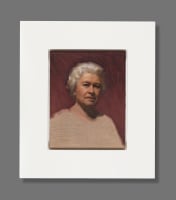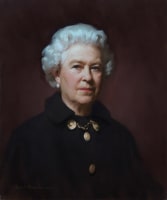This intimate likeness of Her Late Majesty Queen Elizabeth II was painted from life by Rupert Alexander over three sittings at Buckingham Palace in 2010. It was painted in preparation for a larger portrait commissioned by the Royal Warrant Holders Association which now hangs in their headquarters in London (fig.1). Due to time limitations, Alexander decided not to work on a full-scale canvas but to instead produce the present head study which he could later use, along with reference photographs, to produce a final portrait in his studio.
The sittings took place in the Chinese Dining Room, The Duke of Edinburgh’s private dining space, which was specifically requested by Alexander due to its dramatic lighting provided by a high north-facing window. Alexander painted The Duke in the same room in 1998 and enjoyed the contrast between the profusion of daylight and the dark cavernous interior. Alexander recalled the complexities of capturing the Queen’s likeness in the present work:
...This intimate likeness of Her Late Majesty Queen Elizabeth II was painted from life by Rupert Alexander over three sittings at Buckingham Palace in 2010. It was painted in preparation for a larger portrait commissioned by the Royal Warrant Holders Association which now hangs in their headquarters in London (fig.1). Due to time limitations, Alexander decided not to work on a full-scale canvas but to instead produce the present head study which he could later use, along with reference photographs, to produce a final portrait in his studio.
The sittings took place in the Chinese Dining Room, The Duke of Edinburgh’s private dining space, which was specifically requested by Alexander due to its dramatic lighting provided by a high north-facing window. Alexander painted The Duke in the same room in 1998 and enjoyed the contrast between the profusion of daylight and the dark cavernous interior. Alexander recalled the complexities of capturing the Queen’s likeness in the present work:
In portraiture one often has the choice between depicting the sitter as you find them
– i.e. what one can glean of the true nature of the person - or of painting their public
persona with all the formal symbols of their role. I generally find the former more
interesting. I therefore pared back the outfit, doing away with the crown and the
jewels, and sought to convey a sense of Her Majesty’s natural nobility, rather than
the nobility automatically invested in the crown.
Alexander’s reputation as a portrait painter is steadfast. He was heralded as the youngest artist to paint the British Royal Family since the eighteenth century when, in 1998 aged just 23, he painted The Duke of Edinburgh.[1] Thus began his longstanding association with the family which culminated in the present commission in 2010. Alexander later reflected on his sittings with Elizabeth and his recollections echo the sentiments of those who had previously been granted the same rare privilege:
I found her to be open, kind, humorous and, perhaps above all, entirely
without ego.
[1] The Royal Warrant Holders Association awarded Alexander the prestigious QEST scholarship to study at the renowned Florence Academy of Art.













